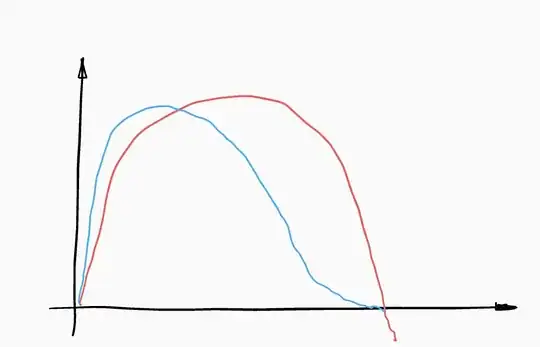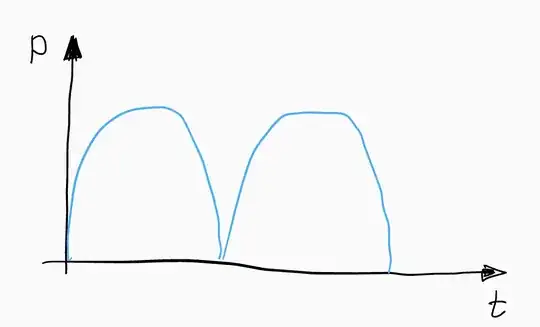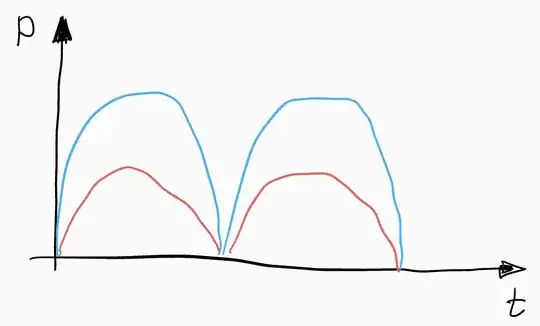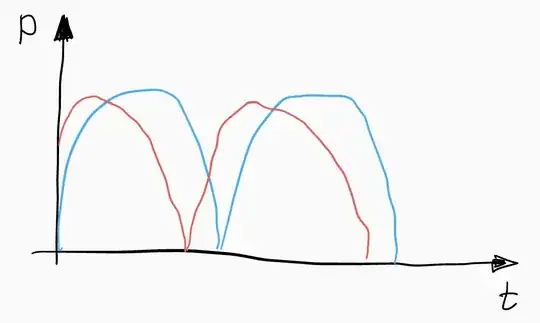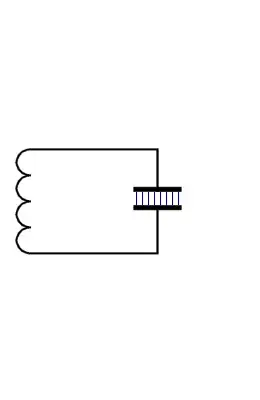It's important to be clear about definitions.
Power in this context is usually defined as the product of root-mean-square (RMS) voltage and current. Assuming transmission of an unmodulated carrier, power is constant over time because RMS current and voltage are constant over time, by the definition of RMS.
It makes no sense to think about power "between" the peaks and valleys of current or voltage. All electromagnetic radiation oscillates at some frequency, and thus must necessarily cross zero periodically. If the voltage and current didn't cross zero, there could be no oscillation, and thus no radiation.
Instead of power, what about just voltage? Again assuming only an unmodulated carrier, voltage is exactly a sine wave. This holds true at any antenna length, at any frequency, and even if there are capacitors or inductors as part of the antenna.
I'm guessing by your drawing you're thinking the antenna looks somehow like a capacitor to the transmitter. But it does not: typically the antenna is tuned so that it looks like a resistor, because the antenna is tuned to be resonant. Resonance is by definition a zero reactance, so the antenna impedance must be resistive.
What if the antenna isn't resonant? Well, in that case we can just forget about antennas and just ask what happens if an AC voltage source is connected to a capacitor:

simulate this circuit – Schematic created using CircuitLab
The answer is the voltage across the capacitor is still sinusoidal. It has to be, by definition of how voltage sources work. The voltage across C1 is equal to the voltage across V1, by Kirchoff's voltage law.
What about current? Also sinusoidal. The current through a capacitor is given by the equation:
$$ I(t) = C {\mathrm d V(t) \over \mathrm d t} $$
where $t$ is time, $C$ is capacitance, and $V$ is voltage. If $V(t)$ is some sinusoidal function, then by basic calculus it should be clear $I(t)$ is another sinusoid, shifted 90 degrees in phase and scaled in amplitude by a factor of $C$.
The only time the voltage between any two points in any antenna, or the current through any segment of an antenna is not a sinusoid is when the signal being transmitted is not a sinusoid. Even then, in practice it's usually pretty close to a sinusoid, especially if we're only looking at a few cycles since any modulation which would modify the sinusoid is usually slow compared to the period of the oscillation.
By Fourier analysis we can see that anything which isn't pretty close to a sine wave will contain energy on many frequencies. When a transmitter is transmitting on unintended frequencies that's called interference, and a good part of an RF engineer's job is avoiding precisely that, since it tends to make the legitimate users of those unintended frequencies upset.
